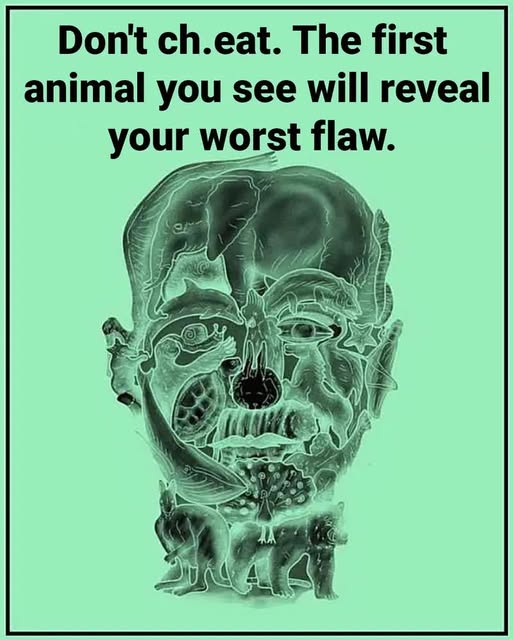A new viral image circulating across social media platforms is captivating users with its bold claim: it can reveal your “worst flaw” based solely on the first animal you see. At first glance, the illustration appears to be a stylized human face—but upon closer inspection, it’s full of cleverly hidden animal figures, each said to correspond to a particular negative personality trait. While there’s no scientific evidence to support these claims, the image is proving to be wildly popular, not for its accuracy, but for the entertainment and introspection it inspires.
The concept behind the test is simple: look at the image quickly and without overthinking. The first animal your eyes land on is said to reveal a dominant character flaw—one you may or may not be consciously aware of. The charm of the test lies in its simplicity and immediacy. There’s no lengthy questionnaire or complex evaluation—just a brief glance, followed by a bit of self-reflection or a laugh depending on what you see.
According to the interpretation guide that accompanies the image, each animal carries its own symbolic meaning. Spotting an elephant, for instance, is said to suggest stubbornness—a refusal to let go of ideas or grudges. Seeing a pig supposedly points to indulgence or an overreliance on comfort. If you notice an iguana first, the message is emotional distance, a sign that you may have trouble connecting on a deeper level. A cricket implies a tendency toward anxiety, and a horse represents pride or a need to appear strong and independent at all costs.
The list doesn’t stop there. Many other animals are hidden in the image, each tied to a unique interpretation. A dolphin could suggest impulsiveness or a love for excitement without much thought for consequences. A bear is said to reveal a rigid or inflexible personality, while a fox might hint at avoidance—running from problems rather than facing them head-on. If a rabbit jumps out at you, it may point to insecurity. Seeing a toucan could mean you crave attention or validation from others.
Some of the other interpretations include the kangaroo, symbolizing inconsistency or emotional unpredictability; the peacock, representing vanity and the need to be admired; the turtle, implying over-cautiousness and a reluctance to take risks; and the whale, said to be a marker of emotional isolation or carrying a heavy internal burden. A gorilla, on the other hand, is linked to dominance or a tendency to overpower others in conversation or relationships.
Additional meanings include the duck (prone to mood swings), the starfish (escapism and avoidance of responsibility), the snake (manipulative behavior), the sloth bear (chronic procrastination), the bird (emotional instability), and the snail (resistance to change). The test is designed more as a mirror of possibilities than a definitive judgment. It’s not diagnostic; it’s playful—an imaginative exercise meant to spark conversation or introspection.
What makes these visual tests so shareable and engaging is that they mix curiosity with just the right amount of challenge. They’re not meant to be taken too seriously, but they often hit a nerve because, at some level, everyone wonders about their own flaws. The humor and surprise that come from seeing yourself through the lens of an animal you didn’t expect make the test feel personal, even when it’s based on random association.
People across platforms are sharing their results, tagging friends, and laughing about how “accurate” or “off” their revealed flaw seems. It becomes a moment not just of reflection but of connection—an easy, accessible way to turn inward briefly or to bond over self-deprecating humor. And while no animal in an optical illusion can truly define you, it might highlight something worth thinking about—or simply give you something to laugh about with friends over coffee or in a group chat.
At the end of the day, real growth and self-awareness come from deeper exploration, not a viral image. But if this test encourages a pause for thought or brings people together in a lighthearted way, it still has value. After all, introspection doesn’t always have to be heavy or serious—sometimes it begins with a simple question: What did you see first?



